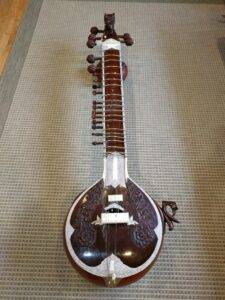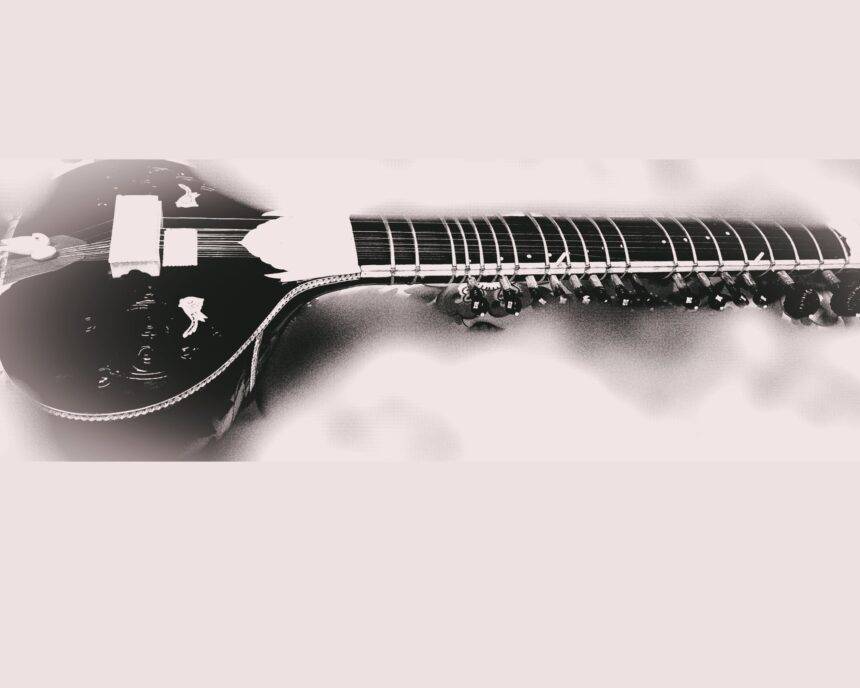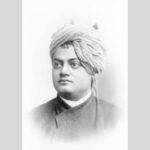Musical instruments have historically emerged from a desire for artistic expression and aesthetic enjoyment. The Sitar, which has undergone various stages of development, is an example of such an instrument. One of the noteworthy inventions stemming from the Sitar is the Surbahar, which may not be widely recognized but is nevertheless essential to any comprehensive discussion of the Sitar. The process of molding musical instruments according to aesthetics is a complex and highly skilled task. It involves a combination of technical knowledge, artistic vision, and an understanding of the unique qualities of each instrument and its musical tradition. In the context of musical instrument-making, aesthetics is concerned with the visual appearance of the instrument as well as its sound quality and playability.
Although the overall structure of Surbahar resembles the Sitar, it has technical differences that make the instrument unique. The materials used, the shape and design of the instrument, the finish and ornamentation, and the overall feel of the instrument. The choice of materials and their quality have a significant impact on the sound and tone of the instrument, while the shape and design affect its playability and ergonomics. Surbahar was created according to the aesthetics of the time and the musical tradition. The Surbahar had a unique shape, with a flat resonator and a wide fingerboard that allowed for the execution of complex alapchari anga. The instrument was also decorated with intricate designs and carvings, making it not only a functional instrument but also a work of art.

The Surbahar was created in the early 19th century and remained popular until the beginning of the 20th century. It was traditionally played by musicians who were knowledgeable and sound in the rendition of alap and jodalap anga. The instrument is made from tun, teak, or deodar wood, with a flat gourd resonator similar to the kachhua sitar. It has a fingerboard that is quite wide with 17 to 19 metal frets, and two bridges fixed upon the soundboard, one for the main strings and the other for sympathetic strings. The Surbahar has seven main strings, including two chikaris (drone), and eleven to twelve sympathetic strings fixed upon the fingerboard just below the main strings. The sound of the Surbahar is deep and mellow, and its wide fingerboard allows the string to be stretched, enabling the player to play notes of even one octave higher from each fret on the main playing string itself. The resonance and sustenance of sound are also greater than that of the Sitar. The Surbahar was used mainly for alapchari or anga, which is more suitable for slow, sustained music, while the Sitar was better suited for fast rhythmic pieces. While Surbahar and Sitar look similar, the former had a few distinctive features other than those of the latter. For instance, the Surbahar had sharp-edged, flatter, straight frets resembling the shape of been frets instead of the round elliptical-shaped frets of the Sitar. The soundboard (tabli) of Surbahar also bore a small cut after the main bridge, and all the sympathetic strings were tied inside this hole under the tabli.

Annapoorna Devi playing Surbahar.
The Surbahar was created to meet the melodic needs of Indian classical music. Indian classical music is a highly complex and intricate system of music that has been developed over thousands of years. It is based on a system of ragas, which are melodic frameworks that are used as a basis for improvisation. The Surbahar was designed to provide a deeper and richer sound than the Sitar, which is a similar instrument but with a higher range. The lower range of the Surbahar allows for a more contemplative and meditative sound, which is particularly suited to the slower and more introspective ragas. In addition to its lower range, the Surbahar also has a longer neck than the Sitar, which allows for greater control and precision in playing. This makes it a popular choice for musicians who specialize in the slow and intricate alap section of a raga, which is the section where the musician establishes the melodic framework of the raga. Overall, the Surbahar was developed to meet the specific melodic needs of Indian classical music, and it has become an important instrument in the repertoire of many Indian classical musicians.
Despite the Surbahar, being constructed and played similarly to the Sitar, is recognized as a separate instrument owing to its bigger size and deeper sound. It has a longer neck, thicker strings, and a wider fretboard than the Sitar. Additionally, the Surbahar is tuned lower than the Sitar, providing a range of up to three octaves. As a result of its unique tonal characteristics and deeper range, the Surbahar is mainly used to play the alap section in Indian classical music. In the past, when the Sitar had limited melodic capabilities, the alap was played on the Surbahar while the Sitar was reserved for playing the drut gats. The Surbahar is played with a similar technique to the Sitar, but due to its larger size and longer neck, it requires a different playing posture and approach. The musician must sit cross-legged with the instrument placed on the ground, tilted slightly towards the player. The strings are plucked with a wire plectrum or mizrab, and the frets are pressed with the fingers to create the desired notes and embellishments. The Surbahar’s unique design also allows for the use of sympathetic strings, which resonate with the main strings to create a rich, layered sound.
Today, the Surbahar continues to be an important instrument in the field of Indian classical music. Although it is not as popular as the Sitar, it is still highly respected and sought after by musicians who specialize in the genre. The Surbahar’s distinct tonal qualities and deeper range make it ideal for playing certain types of compositions and for providing a rich, resonant sound in ensemble performances. While it may not be as widely used as the Sitar, the Surbahar remains an essential part of India’s musical heritage and an important instrument for musicians seeking to explore and express the nuances of Indian classical music.









